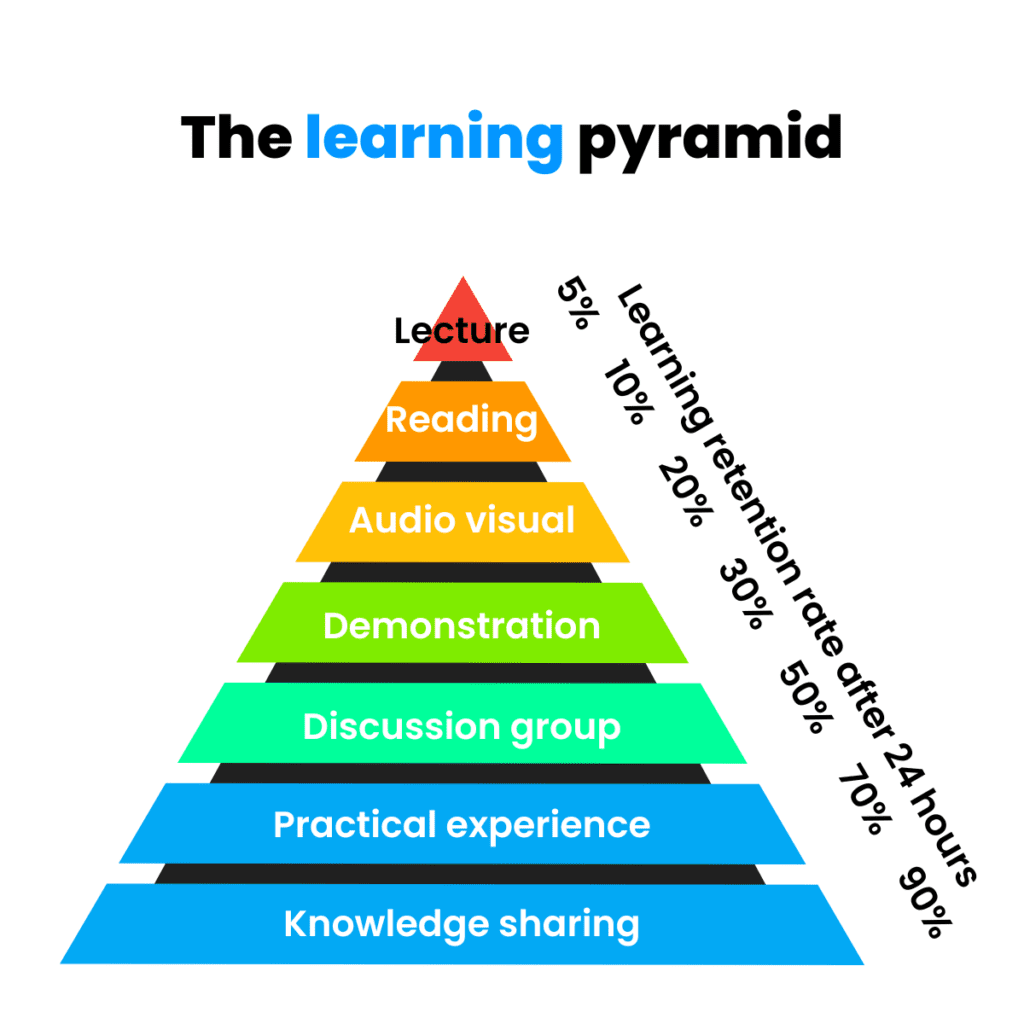
In the world of professional development, the ultimate goal is not just to acquire knowledge but to retain and apply it effectively.
Learning retention plays a crucial role in ensuring that the time and effort invested in learning are not in vain.
For L&D professionals this is vital to ensure that the learning content you’re creating is sticking.
Keep reading to learn:
- What learning retention is
- What the principles of learning retention are
- Why learning retention is important
- The benefits of good learning retention
- Strategies to improve learning retention
Let’s get started.
What is learning retention?
Learning retention refers to the ability of individuals to retain and remember information, knowledge, and skills they have acquired through the learning process.
It involves the long-term storage and application of learned content, ensuring that learners can recall and apply what they have learned over time.
Effective learning retention is crucial in education and training settings as it enhances the overall learning experience and enables individuals to build upon previously learned concepts.
Various factors contribute to learning retention, including the use of effective instructional techniques, active engagement in the learning process, reinforcement and practice, and creating connections and relevance to real-world applications.
What is the learning retention pyramid?
The learning retention pyramid, also known as the cone of learning or the pyramid of retention, is a theoretical model that illustrates the various methods of learning and their respective expected percentages of retention.
The pyramid suggests that different learning methods have different degrees of effectiveness in promoting long-term retention of information.

According to the learning retention pyramid model, passive learning methods, such as lectures, are considered to have lower retention rates, while active learning methods, such as practice and hands-on activities, are associated with higher retention rates.
The pyramid also highlights the importance of engaging learners through activities, discussions, and application to enhance retention.
Additionally, relevant and meaningful learning experiences are believed to have a stronger impact on retention.
It is important to note that the learning retention pyramid has received both support and criticism within the field of education.
Some view the pyramid as a helpful guideline for instructional design, while others argue that the percentages and hierarchy of retention are oversimplified and not supported by robust evidence.
What are the principles of learning retention?
The principles of learning retention can vary depending on the context and sources.
However, some common principles include:
1. Active engagement
Learners retain information better when they actively engage in the learning process through activities, discussions, and application
2. Relevance and meaning
Learning is more likely to be retained when it is perceived as relevant and meaningful to the learner’s interests, goals, and experiences
3. Repetition and practice
Repeated exposure and practice of learned material help reinforce memory and enhance retention
4. Chunking
Breaking down complex information into smaller, manageable chunks can aid retention and facilitate understanding
5. Retrieval practice
Regular retrieval of learned information through quizzes, tests, or recall exercises strengthens memory and improves retention
6. Spaced repetition
Distributing learning and review sessions over time, with increasing intervals between sessions, promotes long-term retention
7. Visual aids and multi-modal learning
Incorporating visual aids, multimedia resources, and multi-modal approaches (e.g., combining text with images or audio) can enhance comprehension and retention
It is important to note that the effectiveness of these principles may vary among individuals and learning contexts.
Therefore, it is beneficial to consider individual learning preferences and adapt instructional strategies accordingly.
Why is learning retention important?
Learning retention refers to the ability of individuals to retain and remember information, knowledge, and skills they have acquired through the learning process.
It involves the long-term storage and application of learned content, ensuring that learners can recall and apply what they have learned over time.
Effective learning retention is crucial in education and training settings as it enhances the overall learning experience and enables individuals to build upon previously learned concepts.
Various factors contribute to learning retention, including the use of effective instructional techniques, active engagement in the learning process, reinforcement and practice, and creating connections and relevance to real-world applications.
Benefits of good learning retention
There are many benefits to good learning retention. Tracking it is key to understanding the true impact of your learning content.
Many L&D professionals use the Kirkpatrick evaluation model when analysing their learning content and this can be a good way to evaluate your strategy.
The benefits of learning retention can generally be summed up as:
- Comprehensive understanding
- Skill development
- Long-term success
- Motivation and confidence
Let’s look at each in more detail.
Comprehensive understanding
Retained information forms a solid foundation for continuous learning, allowing learners to build upon previously acquired knowledge and make connections between different concepts.
This fosters a more comprehensive and holistic understanding of the subject matter.
Skill development
Retention of information is crucial for skill development.
Skills such as problem-solving, critical thinking, and decision-making require a solid foundation of knowledge and the ability to recall and apply it effectively.
By retaining information, learners can develop and refine these skills over time.
Long-term success
Many subjects and disciplines are cumulative, with new concepts building upon a foundation of previously learned material.
Without retention, learners may struggle to grasp more advanced topics or fail to see the relevance and application of what they have learned.
Retention sustains long-term success and ensures a strong knowledge base.
Motivation and confidence
Retained information contributes to learner motivation and confidence.
When learners can recall and apply what they have learned, they experience a sense of accomplishment and competence, which in turn boosts their motivation to continue learning and pursue further challenges.
Strategies to improve learning retention
To help employees retain their learning better, here are nine strategies that organisations can implement.
- Pre-assessment and goal setting
- Active learning techniques
- Microlearning
- Real-world context and application
- Continuous reinforcement
- Gamification
- Learning support and resources
- Regular knowledge checks
- Follow-up opportunities
Let’s look at each of these strategies in more detail.
Pre-assessment and goal setting
Before training or learning initiatives, conduct a pre-assessment to gauge employees’ existing knowledge and skills.
This will allow you to tailor the learning experience to their specific needs. Set clear learning goals with employees, giving them a sense of direction and purpose.
Active learning techniques
Encourage active learning techniques that engage employees in the learning process.
Incorporate interactive elements like group discussions, case studies, role-playing, and hands-on activities. Active learning promotes deep understanding, concept application, and long-term retention.
Microlearning and spaced repetition
Break down learning content into bite-sized modules or microlearning sessions. Spaced repetition involves revisiting and reinforcing key concepts at regular intervals over time.
This approach not only aids retention but also makes learning more manageable and less overwhelming.
Real-world context and application
Make the learning experience relevant to employees’ daily work by providing real-world examples and scenarios.
Help them understand how the newly acquired knowledge and skills can be directly applied in their roles and responsibilities. This connection strengthens retention by embedding learning in their practical context.
Continuous reinforcement
Learning doesn’t end with a single training session. Implement continuous reinforcement techniques to promote ongoing learning and retention.
This can include regular follow-up sessions, knowledge sharing platforms, mentoring, coaching, and opportunities for practice and application.
Gamification and interactive learning
Leverage gamification elements to make learning engaging and enjoyable. Incorporate quizzes, challenges, leaderboards, and rewards to increase motivation and active participation.
Interactive learning experiences capture employees’ attention and enhance retention by making the learning process immersive.
Learning support and resources
Provide employees with access to learning support and resources beyond the training session.
This can include job aids, online libraries, reference materials, video tutorials, and communities of practice. By offering readily available resources, employees can reinforce their learning and address knowledge gaps when needed.
Regular knowledge checks and assessments
Incorporate regular knowledge checks and assessments to evaluate employees’ understanding of the learning material.
This can take the form of quizzes, tests, simulations, or practical assignments. These assessments not only validate learning but also prompt employees to review and retain information.
Follow-up and application opportunities
Create opportunities for employees to apply their newly acquired knowledge and skills in real-world situations.
Provide projects, assignments, or stretch assignments that allow them to use what they have learned.
Encourage feedback and reflection to reinforce learning and identify areas for growth.
Start boosting the learning retention of your employees
Simply providing employees with learning opportunities is not enough; organisations must also prioritise employee learning retention.
By implementing strategies such as pre-assessment, active learning, spaced repetition, real-world application, continuous reinforcement, gamification, learning support, knowledge checks, and follow-up opportunities, organisations can enhance retention and ensure that learning translates into improved job performance.
Prioritising employee learning retention not only benefits individual employees but also contributes to the overall success of the organisation.
Learn more about our platform and what our features can do to help you simplify your learning processes. Book a demo with the team to learn more.

